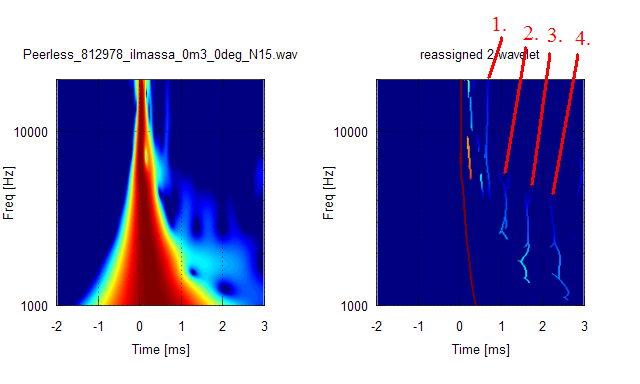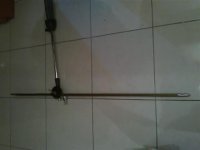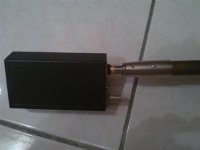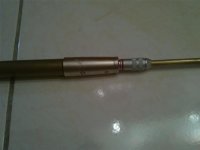I listened to Gary's TD15M impulse response at very low spead (1/40 speed) and I think one can clearly identify a dampened back wall reflection. Following up there is a small amplitude but only slowly decaying train of brighter echoes until the first wall/floor reflections appear and the echo contours slowly disintegrate more and more into reverb.
In a perspective S-transform view the start of the IR looks like this, initial pulse ridge to left, the ridges of the first discrete reflections to the right (decreasing frequency along depth axis, X axis is 1ms/div, Y is 5dB/div), and the above mentioned low level echoes might be identified in the pretty repetitve pattern in between.
Klaus
Wow, That is a post that want to say.....You are damn good!!! I didnt know a person could listen to an impulse at very low speed and post the details of what is happening.
Extremely impressive. Love the graphs too.
Hi Gary,
After measuring and listening to the TD15M, have you given new consideration to a 3-way with a 1" compression driver covering 900/1000Hz to 20kHz? I'm sure you have favorite Soprano recordings for testing. Since I love the women, my midrange covers 80-1,500Hz to minimize splitting their vocals on two speakers.
The B&C 250 and BMS 4550 1" compression drivers sound very good over a wide BW. Even the $40 Selenium D220TI on a 15"-18" waveguide gets approval in my home.
I'd like to talk abou a "vocal range" speaker. The "Vocal_range" covers normal male and female singing voices roughly from 80 Hz to 1100Hz (E2 to C6).
I believe the best speakers do not put a crossover in the 80-1,100Hz vocal range. I've been using the 8" Tang Band W8-1808 and 10" Lambda TD10M.
For non-conductors:.
The following are the general vocal ranges associated with each voice type using scientific pitch notation where middle C=C4. Some singers within these voice types may be able to sing somewhat higher or lower:
Soprano: C4 – C6
Mezzo-soprano: A3 – A5
Contralto: F3 – F5
Tenor: C3 – C5
Baritone: F2 – F4
Bass: E2 – E4
After measuring and listening to the TD15M, have you given new consideration to a 3-way with a 1" compression driver covering 900/1000Hz to 20kHz? I'm sure you have favorite Soprano recordings for testing. Since I love the women, my midrange covers 80-1,500Hz to minimize splitting their vocals on two speakers.
The B&C 250 and BMS 4550 1" compression drivers sound very good over a wide BW. Even the $40 Selenium D220TI on a 15"-18" waveguide gets approval in my home.
I'd like to talk abou a "vocal range" speaker. The "Vocal_range" covers normal male and female singing voices roughly from 80 Hz to 1100Hz (E2 to C6).
I believe the best speakers do not put a crossover in the 80-1,100Hz vocal range. I've been using the 8" Tang Band W8-1808 and 10" Lambda TD10M.
For non-conductors:.
The following are the general vocal ranges associated with each voice type using scientific pitch notation where middle C=C4. Some singers within these voice types may be able to sing somewhat higher or lower:
Soprano: C4 – C6
Mezzo-soprano: A3 – A5
Contralto: F3 – F5
Tenor: C3 – C5
Baritone: F2 – F4
Bass: E2 – E4
Thanks for the last graph. It's interesting how little effect the damping has on the frequency response, even from 2Khz and up..
Just a thought. Suppose the td15m would have been crossed at around 800Hz to the LeCleach horn, how much would the dip at 2.5Khz affect the sound quality?
I have little experience with crossover design and I'd like to know, in the eventuality of tackling a similar project, how many octaves of flat frequency should I aim around the crossover point.
Thank you!
I have the TD series drivers (TD12Ms and TD12S) I scratched my head recent over measurements of non-dampend and dampend cabinets not being that different, I thought I did something wrong. 🙁 Its interesting to see similar results here.
We have to remember that the TD cones are very well treated and completely waterproof. They have a tacky substance which is a pain to clean when dust gets on them. Could this have an effect on the rear wave essentially blocking most of it from coming through?
FWIW, They are the best 12" drivers I have ever heard and they meet the SQ of the expensive JBLs that I have experience. gotta love that 15" response, Im kicking myself for not stepping up to the 15" last year.
Hi Gary,
After measuring and listening to the TD15M, have you given new consideration to a 3-way with a 1" compression driver covering 900/1000Hz to 20kHz? I'm sure you have favorite Soprano recordings for testing. Since I love the women, my midrange covers 80-1,500Hz to minimize splitting their vocals on two speakers.
The B&C 250 and BMS 4550 1" compression drivers sound very good over a wide BW. Even the $40 Selenium D220TI on a 15"-18" waveguide gets approval in my home.
I believe the best speakers do not put a crossover in the 80-1,100Hz vocal range. I've been using the 8" Tang Band W8-1808 and 10" Lambda TD10M.
I have the TD12M and the BMS4550 (QSC HPR-152i waveguide), I have been playing around with different XOs and it seemed the 1200Hz sounded the best but I didnt try any woman vocals.
Considering the overtones, vocals inevitably extend to much higher range. So do other sounds. Now what? This drives us back to the beginning 🙁
Maybe this is the merit of fullranger + helper woofer configutation.
Maybe this is the merit of fullranger + helper woofer configutation.
Last edited:
Interactive Frequency Chart - Independent Recording Network
Awesome chart this is. Hover the curser on the instrument/voice scale and check out the little info bits that show up in the windows on the right-side.
Harmonics of male and female voices extend much higher than 1k. Keeping the crossover out of 100 - 1k should be rule 1.
Awesome chart this is. Hover the curser on the instrument/voice scale and check out the little info bits that show up in the windows on the right-side.
Harmonics of male and female voices extend much higher than 1k. Keeping the crossover out of 100 - 1k should be rule 1.
Last edited:
Looks like close to 2KHz some cone surround interaction.soonsgc,
We must have been on the same...um...wavelength today (sorry!). Earlier this afternoon, I noticed the same thing in the graph, made a drawing just like yours, planned to post it after awhile. But you beat me to it!
Gary Dahl
Keeping the crossover out of 100 - 1k should be rule 1.
Only if you're not good at crossover design. 😉
Great chart, thanks. Best I've ever seen.
Soongsc, you've quoted my spectrograms before. This is not new information. Then I followed it with similar examples just to give a different look. I must be missing something because it sure seems like we new what the problem was 3 pages ago. It was obvious. Can we move on. The wild theories didn't pan out and the simplest one did. I swear I almost can't figure out why I posted this stuff. I thought it was going to be helpful. Silly me. Perhaps someone with more "experience" should restate it. Then we can thank them and move on.
Dan
Dan
All of the 15" AE speakers exihibit this. You can see it in the IR of the TD15X, LO15, and IB15 in my measurements. The wavelength corresponds to 400hz, and again in the nearfield measurements all of these woofer have a dip in the 300-500hz area, ranging from unusable (IB15) to acceptable (the others). I was hoping the TD15M would be free from this since the TD12M doesn't really have it, but I guess I shouldn't be surprised since the LO15 has it and it uses the same top assembly as the LO15.
No driver is perfect unfortunately, but this wouldn't stop me from using these, that's for sure!
No driver is perfect unfortunately, but this wouldn't stop me from using these, that's for sure!
😕I believe I was asking some questions in the "measurements" thread. But I don't know why this kind of response in this thread. Did you design the software and feel annoyed when I use it as reference for discussion?Soongsc, you've quoted my spectrograms before. This is not new information. Then I followed it with similar examples just to give a different look. I must be missing something because it sure seems like we new what the problem was 3 pages ago. It was obvious. Can we move on. The wild theories didn't pan out and the simplest one did. I swear I almost can't figure out why I posted this stuff. I thought it was going to be helpful. Silly me. Perhaps someone with more "experience" should restate it. Then we can thank them and move on.
Dan
Last edited:
Perhaps a silly thought - any possibility that it could be reflections from the inside of the basket legs?
Or have these been treated with felt or similar?
Cheers,
Alex
Or have these been treated with felt or similar?
Cheers,
Alex
Hi,
I suggest using wavelets with reassignment to see reflections and diffractions in both frequency and time domain.
The "Horn Honk" thread has many examples.

- Elias
I suggest using wavelets with reassignment to see reflections and diffractions in both frequency and time domain.
The "Horn Honk" thread has many examples.

- Elias
Hi Elias
glad to see you join the discussion.
Could you perform your wavelet analysis on the IR files at hand.
I already did, but my plots are not as revealing as yours (always several steps behind 😉 - you know..)
The strange thing with this driver seems to be that there is a clear built up in resonance - not exactly what we usually see with looped reflections in horns.
An other explanation possibly would be, that we have a beat of two effects that cause a "come and go" of that resonances (interacting of different modes of cone flexing for example).
Anyway a really strange speaker behaviour worth to look at in detail.
Michael
glad to see you join the discussion.
Could you perform your wavelet analysis on the IR files at hand.
I already did, but my plots are not as revealing as yours (always several steps behind 😉 - you know..)
The strange thing with this driver seems to be that there is a clear built up in resonance - not exactly what we usually see with looped reflections in horns.
An other explanation possibly would be, that we have a beat of two effects that cause a "come and go" of that resonances (interacting of different modes of cone flexing for example).
Anyway a really strange speaker behaviour worth to look at in detail.
Michael
Last edited:
After all the work I've done during the past several days, maybe I should get paid! 😉
Gary Dahl

For that - and - for bringing this thread alive !
Michael
Soongsc, it's in reference to your suspicion of a cone resonance around 2k that you posted 2 posts before my last. We already know it does, you've already seen it in the polar plot and the spectrogram and the impulse. It's just that simple, no reason to re-rediscover it again.😕I believe I was asking some questions in the "measurements" thread. But I don't know why this kind of response in this thread. Did you design the software and feel annoyed when I use it as reference for discussion?
Please can we now end this discussion? Unless we are going to try to fix it, but it seems Gary is content with crossing it over low.
Sorry for getting annoyed, but I hate rehashing the same thing over and over. Yea I know, then why post in this thread?...... Life is too short.
Oye,
Dan
So, I'm not crazy after all?
Well, let's not go that far, shall we? We need to wait for more evidence. 😛
Well, I don't recall anyone pointing out the possibility of interaction between the cone and surround. I don't think anyone pointed out the shape of the wriggles discussed. Seems Gary is also interested in this. So why get annoyed? I would not have even posted the 2Khz issue if the discussion was not on-going. To be honest, I thought it was just some reflection untill I looked at the shape of the wriggle.Soongsc, it's in reference to your suspicion of a cone resonance around 2k that you posted 2 posts before my last. We already know it does, you've already seen it in the polar plot and the spectrogram and the impulse. It's just that simple, no reason to re-rediscover it again.
Please can we now end this discussion? Unless we are going to try to fix it, but it seems Gary is content with crossing it over low.
Sorry for getting annoyed, but I hate rehashing the same thing over and over. Yea I know, then why post in this thread?...... Life is too short.
Oye,
Dan
Inspired by Lynn's mic setup and Gary's mic installation mod; I finally found a way to put together a mod that will integrate existing mic and preamp with the mic stand. A brass tube relaces the original mic holding tube, on one end is the mic preamp, on the other end is the mic.
The next time I get to do some measurements, I'll post any differences I see.
The next time I get to do some measurements, I'll post any differences I see.
Attachments
- Home
- Loudspeakers
- Multi-Way
- Beyond the Ariel


